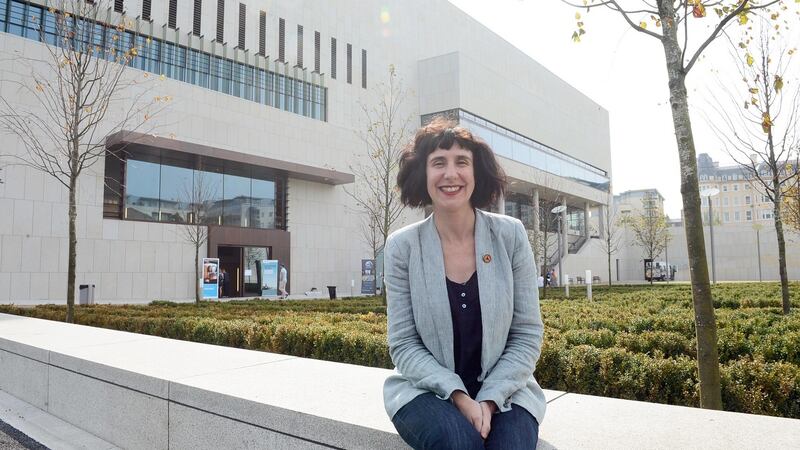“After spending a long time looking at the figures,” wrote Anne Enright in her much-discussed LRB essay from 2017 on the under-representation of women writers in both publishing and reviewing, “anything over 40 per cent feels like a miracle and anything under 30 per cent a crime.”
The fact then that last year 60 per cent of the poets reviewed in The Irish Times were female should be cause for celebration, if not canonisation, particularly given that a 2018 report found that women made up only 37 per cent of poets published in Ireland in the years 2008-2017.
The over-representation of published women poets reviewed in The Irish Times in 2019 was not a one-off. Aggregating the figures for the years 2016 to 2019, 49 per cent of poets reviewed were female, one-third more than might have been expected, given the number of women poets published in those years, a remarkable and recognisable editorial intervention in the market, one would have thought.
This is not to say that our record has always been impeccable. In 2015, only 13 out of 33 poets reviewed were female; in 2014, eight out of 33; and in 2013, five out of 23. What the underwhelming figures for these three years do show, however, is that the overall trend over the past decade was a positive one, arcing towards fairness and parity.
We crunch these unpoetic numbers not to seek praise but to defend our record from attack. Dr Kenneth Keating and Dr Ailbhe McDaid, whose previously mentioned Measuring Equality in the Arts Sector (MEAS) report, Gender in Poetry Publishing in Ireland, 2008-2017, established that Irish poetry publishing disproportionately favoured male poets (63 per cent to 37 per cent), have produced a follow-up report, Poetry Reviews in The Irish Times 2013-2018, which argues that reviews in that period disproportionately favoured male poets (68 per cent to 32 per cent). Remarkably, their argument fails to contextualise this by any reference to their own 2018 report.
Instead, it concludes: “While there have been improvements in certain areas, the overall picture of the very recent history of poetry reviews in The Irish Times presents a clear picture of sustained imbalance in favour of male-authored reviews, and in favour of reviewing male-authored publications.”
The report is likewise critical of the gender imbalance of poetry reviewers in The Irish Times, calling it “a sustained privileging of the male critical voice”, while at the same time claiming that the appointment of John McAuliffe in 2013 as chief poetry reviewer “would naturally lead to an unintended consequence of domination by male-authored criticism”. But the argument about gendered reviewing practices hardly stacks up when, in the wider context of the Irish Times books pages, our YA reviewer is Claire Hennessy; our children’s books reviewer is Sara Keating; our new fiction reviewer is Sarah Gilmartin; and of course for many years our literary correspondent was the late Eileen Battersby. Is this then evidence of “a sustained privileging of the female critical voice”?

Appointing Caitriona O’Reilly and then Martina Evans as joint poetry reviewer was not primarily about gender balance, although that was certainly a consideration but, given John McAuliffe’s position as a poet published by Gallery Press, to avoid any perceived conflict of interest. (A jaded observer might remark that the poetry scene generates more conflicts than interest.) The poetry world is small and full of these overlaps. One of this report’s authors, Kenneth Keating, is also editor of a small press, Smithereens, none of whose 26 publications we have reviewed.
As well as reviewing more poetry than any other Irish, British or indeed Anglophone newspaper over the past decade, The Irish Times has devoted a lot of attention to the issue of gender balance in Irish poetry, publishing and in the arts generally. Consider this article by Christine Murray: Tackling the catastrophic canonical neglect of Irish women poets and writers; this by Sinéad Gleeson: A profound deafness to the female voice; and Deirdre Falvey's investigation into the previous MEAS report: Two-thirds of published poets are male, so does poetry have a gender issue?
The academics’ report goes on to criticise The Irish Times’s coverage on the grounds of race and ethnicity. In the period considered, 81 per cent of poets reviewed (153) were Irish. None of these Irish poets, it says, are BAME, a term used in Britain to group people from Black, Asian and Minority Ethnic backgrounds. The authors do not offer a single example of a collection by an Irish BAME author or cite what percentage of poetry published here is by a BAME poet, obscuring the possibility that it is perhaps zero. In fact, race is not included as a category in any previous MEAS report, which makes it difficult to accurately assess any possible imbalance between our reviewing of BAME writers and the actuality of the publishing landscape in Ireland.
To quote Michael Connelly’s detective Harry Bosch: “Everybody counts or nobody counts.” In this context, that means if you are going to count the race and ethnicity of every poet reviewed in The Irish Times, then it is only fair to count the race and ethnicity of every Irish poet published to make a meaningful comparison.
The latest report does acknowledge that Irish publishing is “severely lagging behind” because of “editorial failings and biases” but is unwilling to “absolve The Irish Times of responsibility for the significant racial imbalance” as only three (in fact, it is four – it cites both figures: Vahni Capildeo, Derek Walcott, Ocean Vuong and Maryam Al-Masri ) out of 35 non-Irish poets reviewed were BAME, which translates as 11.4 per cent. We also highlighted two other UK-published BAME poets, Kei Miller and Danez Smith, in end-of-year best-of columns.
In the 2011 census, 12.9 per cent of the UK population identified as BAME, but again, the report offers no benchmark for what would be appropriate here, no statistic for the proportion of BAME poets published here or elsewhere, or definition of how this British term relates here or in a global context, yet concludes this "underscored the extent to which The Irish Times continues to privilege white voices and marginalise BAME poets".
In fact, an internet search unearths Sandeep Parmar’s 2019 report, The State of Poetry and Poetry Criticism in the UK and Ireland 2011-2018, which found that 8.13 per cent of books reviewed in that period were by BAME poets, a significantly smaller figure than that achieved by The Irish Times.
No one would dispute that the pattern of immigration and its subsequent influence on the arts and society are very different in Britain and Ireland. BAME poets in Britain are winning major prizes (Vahni Capildeo; Raymond Antrobus; Roger Robinson) whereas in Ireland they are still working on their debut collections. They are making their presence felt in anthologies, however – Landing Places: Immigrant Poets in Ireland Eds. Eva Bourke and Borbála Faragó (Dedalus Press, 2010) and Writing Home: 'New Irish' Poets, edited by Pat Boran and Chiamaka Enyi-Amadi (Dedalus Press, 2019) – both of which we have featured.
When poet Jessica Traynor and actor Stephen Rea created Correspondences, giving voice to the experiences of people living in Direct Provision centres, not only did we review it, but we ran a feature about the making of it.
This week, to mark Australia Day, we published a significant essay by Felicity Plunkett on Australia's First Nations poets, reflecting the burgeoning success of Indigenous writers there and, incidentally, our commitment to diversity. As it is a feature, not a review, however, it would not have registered in the MEAS report. Likewise, Ian Duhig's interview with Sinéad Morrissey from 2017, to mark her winning of the Forward Prize. Or this news feature marking Raymond Antrobuswinning the Rathbones Folio Prize. Or this feature devoted to Rachael Hegarty's collection of poems addressing the Dublin bombings in 1974, May Day 1974, published by Salmon Poetry.
Or consider these three surveys of Irish poets' favourite love poems to mark St Valentine's Day: 'Take your clothes off': Poets reveal their favourite love poems; Love poems: 'For one night only naked in your arms' – 14 poets pick their favourites; and Valentine's Day: Impress them with these love poems. Of the 46 poets invited to contribute, 25 are women.
In the years covered in this report, we have also greatly expanded our coverage of poetry online, broadening and deepening our engagement. None of this is considered worthy of note. Take, as a random sample, this 2015 essay by Doireann Ní Ghriofa on the inspiration for her collection, Clasp; this 2016 feature by Mary O'Malley on her collection, Playing the Octopus (Carcanet); this 2017 article by poet and critic Martina Evans on love poetry and love stories; this 2018 interview with Sydney-based poet Anne Casey; and this 2019 article by Jenny Farrell about The Children of the Nation: An Anthology of Working People's Poetry from Contemporary Ireland, which she edited.
WH Auden may not have foreseen this report’s particular use of statistics when he wrote his commencement address for graduating Harvard students, Under Which Lyre, a poem which poked fun at quantity-measuring approaches to art, and life: “Thou shalt not sit / With statisticians nor commit / A social science”. However, he – and most readers of poetry – would understand the problem of reading poetry from a populist, levelling perspective, which sets aside national and international reputation and achievement, and dismisses the painstaking discussion about quality and value, alongside the obvious editorial concern with representation, which inform our critics’ choices.
The report never acknowledges the absolute bedrock of literary criticism, which is selection on merit. Nor does it acknowledge that The Irish Times is a commercial organisation that has to have one eye on popular interest and appeal. It goes so far as to question how often we have reviewed Paul Muldoon, for example. It may as well have questioned why Seamus Heaney gets so much attention. It also questions the disproportionate amount of reviews of Gallery Press titles to the detriment of what they describe in Stakhanovite terms as “highly productive presses”. The answer is simple: because Gallery publishes many of our finest poets, such as Eiléan Ní Chuilleanáin; Nuala Ní Dhomhnaill; Medbh McGuckian; Vona Groarke; Derek Mahon; Ciaran Carson; and Muldoon.
The Irish Times takes pride in our commitment to poetry, which is reflected not only in our reviews but in features and interviews too; in the original poem we publish each week; the poems we publish each month as part of our New Irish Writing; and the annual 'Irish Times' Poetry Now award, presented as part of Mountains to Sea dlr book festival. We welcome all feedback; we do not claim to be perfect; but we do not recognise how we have been portrayed in this report. Of all the national newspapers in Ireland, The Irish Times is the only one to devote the considerable resources and attention required to cover poetry well. To have been singled out in this report is, I suppose, a backhanded compliment. Since it is the only one that it pays us, I suppose we shall have to take it.
Martin Doyle is Books Editor of The Irish Times





















